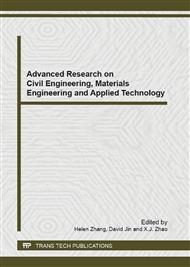[1]
J. Gratch, and S. Marsella. A domain-independent framework for modeling emotion, Cognitive Systems Research, vol. 5, no. 4, pp.269-306, (2004).
DOI: 10.1016/j.cogsys.2004.02.002
Google Scholar
[2]
A. Egges, S. Kshirsagar, and N. Magnenat‐Thalmann. Generic personality and emotion simulation for conversational agents, Computer Animation and Virtual Worlds, vol. 15, no. 1, pp.1-13, (2004).
DOI: 10.1002/cav.3
Google Scholar
[3]
R. Marinier III, J. Laird, and R. Lewis. A computational unification of cognitive behavior and emotion, Cognitive Systems Research, vol. 10, no. 1, pp.48-69, (2009).
DOI: 10.1016/j.cogsys.2008.03.004
Google Scholar
[4]
C. Becker-Asano, and I. Wachsmuth. Affective computing with primary and secondary emotions in a virtual human, Autonomous Agents and Multi-Agent Systems, vol. 20, no. 1, pp.32-49, (2009).
DOI: 10.1007/s10458-009-9094-9
Google Scholar
[5]
K. Scherer. Appraisal considered as a process of multilevel sequential checking, Appraisal processes in emotion: Theory, methods, research, vol. 92, p.120, (2001).
Google Scholar
[6]
R. Calvo, and S. D'Mello. Affect Detection: An Interdisciplinary Review of Models, Methods, and their Applications, IEEE Transactions on Affective Computing, vol. 1, no. 2, (2010).
Google Scholar
[7]
A. Newell. Unified theories of cognition, Harvard Univ Pr, (1994).
Google Scholar
[8]
H. Yang, Z. Pan, M. Zhang, et al. Modeling emotional action for social characters, The Knowledge Engineering Review, vol. 23, no. 4, pp.321-337, (2008).
DOI: 10.1017/s0269888908000027
Google Scholar
[9]
M. El-Nasr, J. Yen, and T. Ioerger. Flame—fuzzy logic adaptive model of emotions, Autonomous Agents and Multi-Agent Systems, vol. 3, no. 3, pp.219-257, (2000).
DOI: 10.1023/a:1010030809960
Google Scholar
[10]
C. Elliott. The Affective Reasoner: A process model of emotions in a multi-agent system, (1992).
Google Scholar
[11]
K. LaBar, and R. Cabeza. Cognitive neuroscience of emotional memory, Nature Reviews Neuroscience, vol. 7, no. 1, pp.54-64, (2006).
DOI: 10.1038/nrn1825
Google Scholar
[12]
J. Laird. Extending the Soar cognitive architecture, Proceeding of the 2008 conference on Artificial General Intelligence IOS Press, pp.224-235, (2008).
Google Scholar
[13]
D. Mikami, K. Otsuka, and J. Yamato. Memory-based particle filter for face pose tracking robust under complex dynamics, IEEE Conference on Computer Vision and Pattern Recognition, (2009).
DOI: 10.1109/cvpr.2009.5206661
Google Scholar


